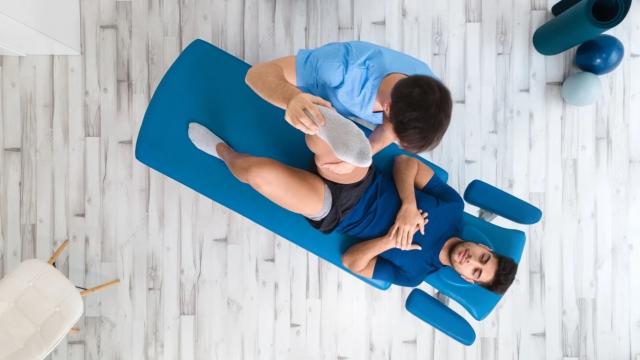Something called “stretch therapy” seems to be trending, with studios opening in shopping centers next to yoga studios and juice bars. Private practitioners are starting to offer it along with massage therapy, personal training, or physical therapy. As you’ve been likely told your entire life, stretching is good for you in terms of preventing and healing soreness and injury, as well as for relaxation and overall health. But how does it stretch therapy work, exactly?
How stretch therapy works
“Stretching involves elongating muscles to improve flexibility of the muscle group and improve the range of motion (ROM) of the joints the muscle(s) cross or affect. Stretching also activates the parasympathetic nervous system, which is responsible for relaxation, reduced systemic inflammation, reduced heart rate (HR) and respiratory rate (RR),” says Adrienne Simonds, PT, PhD, a licensed physical therapist at Rutgers School of Health Professionals.
“Stretch therapy,” meanwhile, “is an umbrella term for various techniques that treat physical issues linked to muscle and joint restriction,” says John A. Gallucci, Jr., MS, ATC, PT, DPT, CEO of JAG Physical Therapy. “The overall goal of stretch therapy is to treat muscle tightness, joint imbalances, and tissue restrictions that cause movement distortions, aches and pains, and increased risk of injury.” Having a professional assist this treatment can increase effectiveness and prevent injury, Gallucci says. “Although the research on stretch therapy isn’t conclusive, stretch therapy over time can help improve your range of motion and athletic performance by improving the flexibility of muscles and connective tissue.”
Many people also find it pleasant and relaxing, especially since stretching alone can often be uncomfortable. Simonds says, “This is one of the advantages of stretch therapy because individuals have the assistance of another person to help with movements and provide ongoing support and encouragement.” A professional can also help you stretch more effectively and without hurting yourself when you’re on your own, and can tailor your treatment plan to your lifestyle.
Who might benefit from stretch therapy?
While anyone can benefit from stretch therapy, Galluci says, “stretch therapy is not for everyone. Response to stretch therapy may depend on your athletic and medical history. If you have been cleared by a medical professional to attempt stretch therapy, it should be beneficial for you.” Your stretch therapist should verify that you are cleared before beginning to work on your body.
Additionally, if you qualify, your treatment plan might vary based on your activity level and locations of tension. Athletes will need different tips than someone who sits at a desk all day, but both benefit. Athletes may have targeted strengthening stretches to decrease the risk of injury, and “an injury prevention program for a work-from-home or in-office employee who sits for most of the workday would include ways to mitigate or reduce the ‘costs’ of prolonged sitting on the low back and hips,” says Simonds. She also says that many people store stress in their bodies, so “it is important to realize that the opportunity to release that stored stress through stretching activities as well as walking, exercise, meditation, and yoga, may contribute more positively to our overall physical and mental health. These benefits may far exceed flexibility and increased range of motion benefits.”
What to look for in a stretch therapist and where to find one
Many types of trainers can offer stretch therapy but not everyone will be right for you. “Since stretch therapy encompasses a variety of techniques used to treat muscle and joint restrictions, there is not a universal stretch therapy certification as of yet,” says Galluci. He says, however, some people who might be qualified to provide stretch therapy “would include being licensed in physical therapy, massage therapy, and chiropractic. Some rehab centers also accept certified yoga instructors and personal trainers.” That means you might see a variety of “certifications” when looking for a stretch therapist. They’re not covered by insurance in most cases, so you can find a stretch therapist the same way you’d find a massage therapist (google, Yelp), from personal or doctor recommendations, or by trying out one of the storefronts offering services. Many have a free or discounted first session.
Simonds advises that “persons engaged in stretch therapy should move deliberately and slowly, attending to the specific movement and stopping at the first moment of resistance to experience the stretch sensation at their own tolerance,” adding, “a slower pace of stretching with longer hold time (30-120 seconds) is more effective than a higher quantity of stretching with shorter hold time (
It’s not a cure-all
Going to stretch therapy alone isn’t going to solve all your problems. (Will anything?) Simonds says, “Effective injury prevention programs include other facets, such as education, body awareness and proprioceptive training, strengthening, a home program, and muscle re-education in high-risk injury positions and activities.” Athletes, people who exercise a lot, and people who exercise rarely and feel tension as a result should all consult with their healthcare providers for their advice on the best way forward.

Leave a Reply
You must be logged in to post a comment.